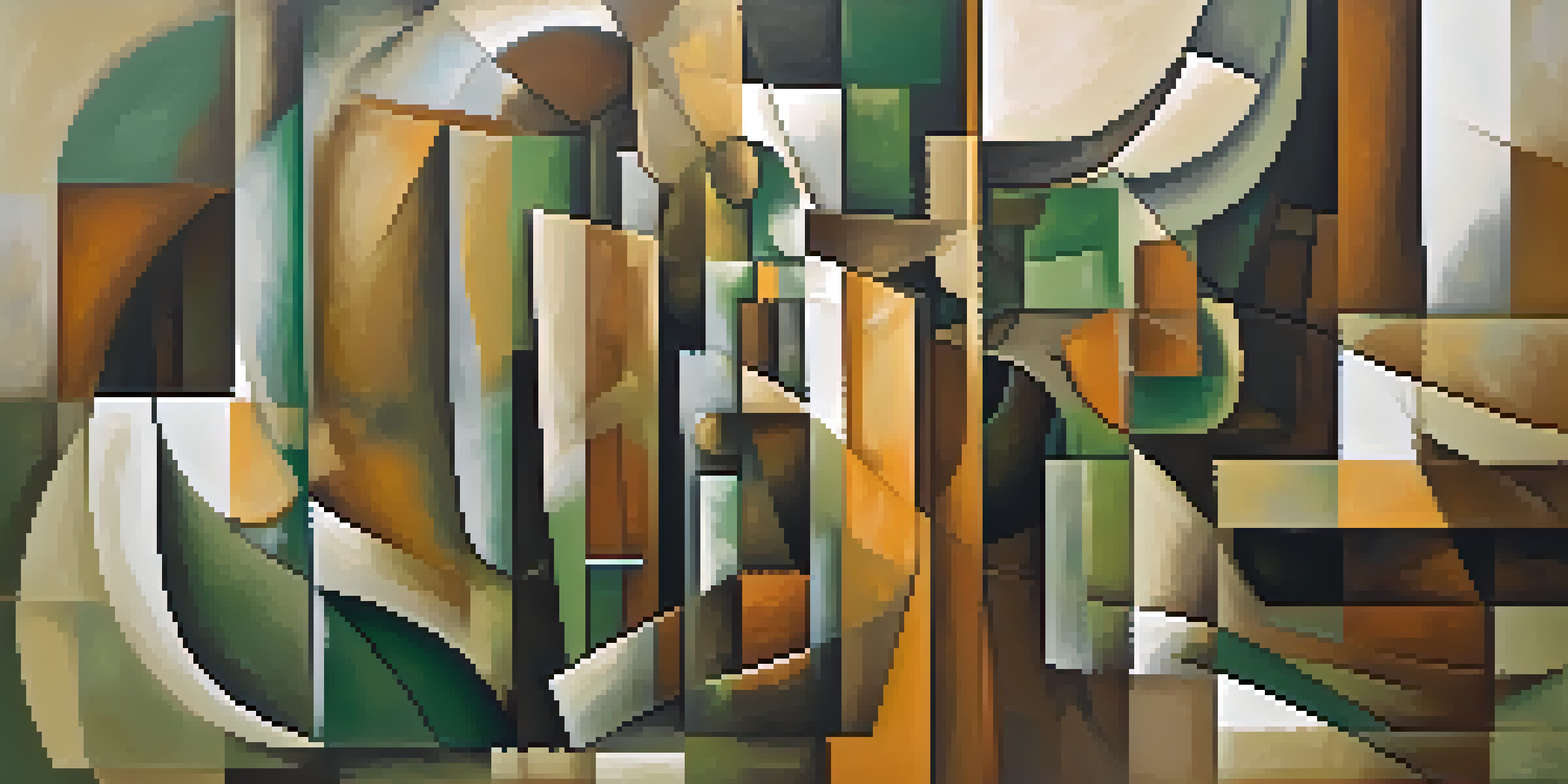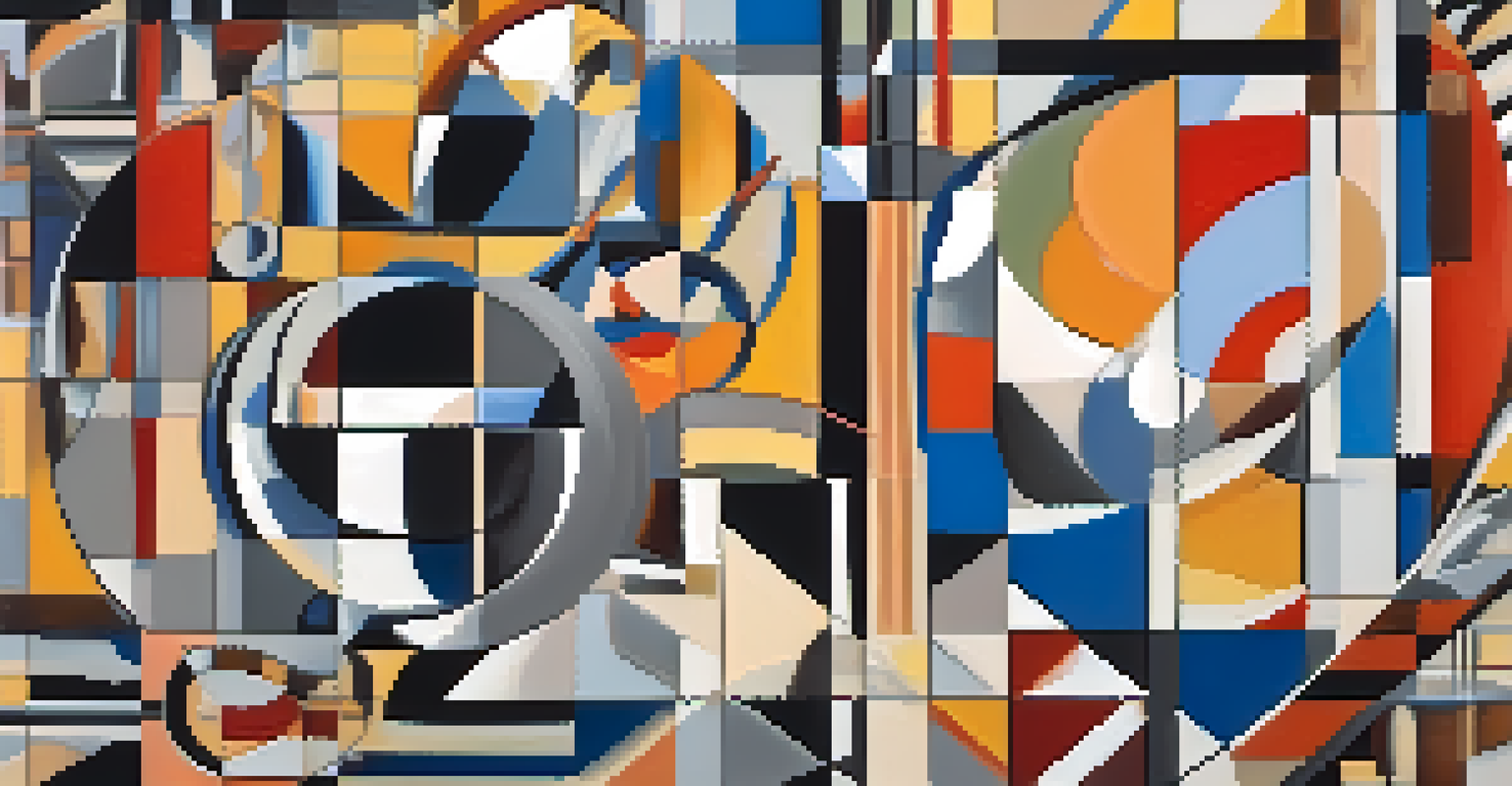The Influence of Cubism on Abstract Painting Techniques

What is Cubism and Why Does It Matter?
Cubism emerged in the early 20th century, primarily through the works of artists like Pablo Picasso and Georges Braque. It broke away from traditional perspectives and instead presented multiple viewpoints within a single canvas. This revolutionary approach not only changed how subjects were depicted but also laid the groundwork for many modern art movements, including abstract painting.
Cubism is a way of seeing, a way of experiencing the world through the eyes of an artist.
By deconstructing objects into geometric shapes and reassembling them in unique ways, Cubism challenged the viewer's perception. This idea of breaking down and reconstructing visual reality was a radical shift that encouraged artists to explore new dimensions of expression. Understanding Cubism is essential for appreciating its profound influence on abstract art.
In essence, Cubism represented a departure from realistic representation, inviting artists to experiment with form and color. This newfound freedom would ripple through the art world, inspiring future generations to push boundaries and redefine their creative processes.
Key Characteristics of Cubism
Cubism is characterized by its use of geometric shapes, fragmented forms, and a focus on multiple perspectives. Artists employed a palette of muted colors, often using browns, grays, and greens to emphasize structure over vibrancy. This focus on form allowed for a more intellectual engagement with the artwork, prompting viewers to think critically about what they were observing.

The technique of breaking down objects into various planes and angles created a sense of movement within the artwork. This dynamism not only captivated audiences but also paved the way for abstract techniques that would follow. As artists began to embrace these characteristics, they found new ways to convey emotion and meaning beyond traditional representation.
Cubism Revolutionized Art
Cubism broke away from traditional perspectives, allowing artists to present multiple viewpoints and fundamentally changing the course of modern art.
Cubism's emphasis on abstraction and simplification influenced countless artists who sought to explore the essence of their subjects. The deconstruction of reality encouraged a dialogue between form and color, setting the stage for the evolution of various abstract styles.
Cubism’s Role in the Evolution of Abstract Art
Cubism served as a crucial turning point in the evolution of abstract art, as it invited artists to break free from the constraints of realism. This shift allowed for the exploration of abstraction in unprecedented ways, paving the way for movements like Futurism, Dada, and Surrealism. Each of these movements took inspiration from Cubism's innovative approach to form and perspective.
The artist is a receptacle for the emotions that come from all over the place: from the sky, from the earth, from a scrap of paper, from a passing shape, from a spider's web.
As artists experimented with abstraction, they began to prioritize emotional expression over literal representation. This shift led to the rise of non-representational art, where the focus was on the interplay of colors, shapes, and lines rather than recognizable subjects. Cubism's influence can be seen in the works of abstract painters like Wassily Kandinsky and Piet Mondrian, who embraced the idea of art as an emotional and spiritual experience.
Through these developments, Cubism demonstrated that art could transcend mere representation and delve into the realm of ideas and feelings. This legacy continues to inspire artists today, as they seek to find new ways to communicate through abstraction.
Techniques Borrowed from Cubism in Abstract Painting
Many abstract painters have adopted techniques first popularized by Cubism, such as fragmentation and the use of geometric shapes. These methods allow artists to create depth and complexity within their works without relying on traditional perspectives. By breaking down forms into simpler components, artists can explore new compositions and relationships between elements.
Another technique influenced by Cubism is the use of overlapping shapes and planes. This layering creates a sense of movement and depth, drawing the viewer's eye across the canvas. Abstract painters use this approach to evoke emotions and provoke thought, much like their Cubist predecessors did.
Techniques Influenced Abstract Art
Cubist techniques, such as fragmentation and geometric shapes, paved the way for abstract painters to explore depth and emotional expression.
Additionally, the Cubist practice of varying viewpoints has also made its way into abstract art. Artists often incorporate multiple angles and perspectives within a single piece, engaging viewers in a dynamic visual experience that challenges their understanding of space and form.
Prominent Abstract Artists Influenced by Cubism
Several prominent abstract artists drew inspiration from Cubism, weaving its principles into their unique styles. Wassily Kandinsky, known for his vibrant use of color and geometric forms, was influenced by Cubism's emphasis on abstraction. He believed that art should evoke emotion, and the fragmented structures of Cubism helped him explore this idea further.
Another artist, Piet Mondrian, took Cubism's geometric shapes to new heights with his distinctive grid-based compositions. While he moved towards a more minimalistic approach, the foundations laid by Cubism were evident in his work. Mondrian's use of primary colors and straight lines showcased how Cubism could evolve into new forms of abstraction.
These artists, among others, highlight the diverse ways in which Cubism has shaped the trajectory of abstract painting. Their innovative approaches demonstrate that Cubism's influence is not just historical; it continues to inspire contemporary artists today.
The Legacy of Cubism in Contemporary Art
The legacy of Cubism remains evident in contemporary art, where its principles continue to inspire new movements and techniques. Modern artists often revisit and reinterpret Cubist ideas, infusing them with fresh perspectives that reflect today's societal and cultural landscapes. This ongoing dialogue between past and present keeps the spirit of Cubism alive.
For instance, many contemporary artists experiment with digital mediums, using technology to create fragmented images that mirror Cubist techniques. This intersection of art and technology allows for a reimagining of traditional concepts, making them relevant in a modern context. The adaptability of Cubism ensures it remains a vital influence in the evolving world of art.
Legacy in Contemporary Art
The principles of Cubism continue to inspire contemporary artists, encouraging them to reinterpret its ideas in today's cultural context.
Ultimately, the impact of Cubism on contemporary abstract painting is profound. Its revolutionary approach to form and perception encourages artists to continue pushing boundaries, exploring new methods of expression, and challenging the viewer's experience.
Conclusion: The Enduring Influence of Cubism
In conclusion, Cubism has left an indelible mark on the world of abstract painting, shaping both technique and philosophy. Its emphasis on breaking down forms and exploring new perspectives has encouraged countless artists to think outside the box and redefine their creative processes. Even over a century later, the ideas birthed from Cubism resonate throughout the art world.
The journey from Cubism to contemporary abstract art illustrates how one movement can inform and inspire future generations. Artists continue to draw from this rich legacy, creating works that challenge conventions and provoke thought. This ongoing influence ensures that Cubism remains a vital part of art history.

As we look to the future, it's exciting to consider how Cubism will continue to evolve and inspire the next wave of artists. Its legacy is not just a chapter in art history; it's a living, breathing force that shapes the way we understand and appreciate art today.